Intel SSD 520 Review: Cherryville Brings Reliability to SandForce
by Anand Lal Shimpi on February 6, 2012 11:00 AM ESTAnandTech Storage Bench 2011
Last year we introduced our AnandTech Storage Bench, a suite of benchmarks that took traces of real OS/application usage and played them back in a repeatable manner. I assembled the traces myself out of frustration with the majority of what we have today in terms of SSD benchmarks.
Although the AnandTech Storage Bench tests did a good job of characterizing SSD performance, they weren't stressful enough. All of the tests performed less than 10GB of reads/writes and typically involved only 4GB of writes specifically. That's not even enough exceed the spare area on most SSDs. Most canned SSD benchmarks don't even come close to writing a single gigabyte of data, but that doesn't mean that simply writing 4GB is acceptable.
Originally I kept the benchmarks short enough that they wouldn't be a burden to run (~30 minutes) but long enough that they were representative of what a power user might do with their system.
Not too long ago I tweeted that I had created what I referred to as the Mother of All SSD Benchmarks (MOASB). Rather than only writing 4GB of data to the drive, this benchmark writes 106.32GB. It's the load you'd put on a drive after nearly two weeks of constant usage. And it takes a *long* time to run.
1) The MOASB, officially called AnandTech Storage Bench 2011 - Heavy Workload, mainly focuses on the times when your I/O activity is the highest. There is a lot of downloading and application installing that happens during the course of this test. My thinking was that it's during application installs, file copies, downloading and multitasking with all of this that you can really notice performance differences between drives.
2) I tried to cover as many bases as possible with the software I incorporated into this test. There's a lot of photo editing in Photoshop, HTML editing in Dreamweaver, web browsing, game playing/level loading (Starcraft II & WoW are both a part of the test) as well as general use stuff (application installing, virus scanning). I included a large amount of email downloading, document creation and editing as well. To top it all off I even use Visual Studio 2008 to build Chromium during the test.
The test has 2,168,893 read operations and 1,783,447 write operations. The IO breakdown is as follows:
| AnandTech Storage Bench 2011 - Heavy Workload IO Breakdown | ||||
| IO Size | % of Total | |||
| 4KB | 28% | |||
| 16KB | 10% | |||
| 32KB | 10% | |||
| 64KB | 4% | |||
Only 42% of all operations are sequential, the rest range from pseudo to fully random (with most falling in the pseudo-random category). Average queue depth is 4.625 IOs, with 59% of operations taking place in an IO queue of 1.
Many of you have asked for a better way to really characterize performance. Simply looking at IOPS doesn't really say much. As a result I'm going to be presenting Storage Bench 2011 data in a slightly different way. We'll have performance represented as Average MB/s, with higher numbers being better. At the same time I'll be reporting how long the SSD was busy while running this test. These disk busy graphs will show you exactly how much time was shaved off by using a faster drive vs. a slower one during the course of this test. Finally, I will also break out performance into reads, writes and combined. The reason I do this is to help balance out the fact that this test is unusually write intensive, which can often hide the benefits of a drive with good read performance.
There's also a new light workload for 2011. This is a far more reasonable, typical every day use case benchmark. Lots of web browsing, photo editing (but with a greater focus on photo consumption), video playback as well as some application installs and gaming. This test isn't nearly as write intensive as the MOASB but it's still multiple times more write intensive than what we were running last year.
As always I don't believe that these two benchmarks alone are enough to characterize the performance of a drive, but hopefully along with the rest of our tests they will help provide a better idea.
The testbed for Storage Bench 2011 has changed as well. We're now using a Sandy Bridge platform with full 6Gbps support for these tests.
AnandTech Storage Bench 2011 - Heavy Workload
We'll start out by looking at average data rate throughout our new heavy workload test:
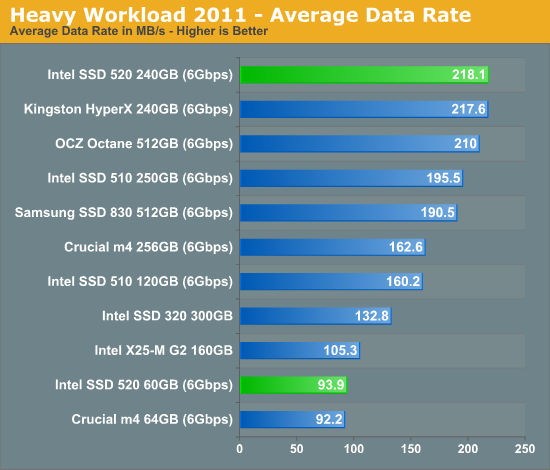
SandForce has always done well in our Heavy Workload test, and the 520 is no different. For heavy multitasking workloads, the 520 is the fastest SSD money can buy. Note that its only hindrance is incompressible write speed, which we do get a hint of in our breakdown of read/write performance below.

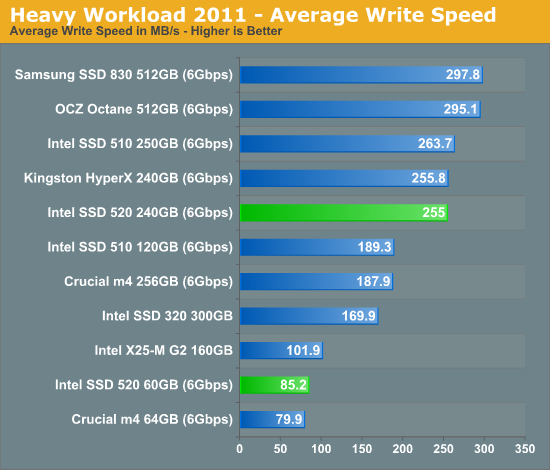
The next three charts just represent the same data, but in a different manner. Instead of looking at average data rate, we're looking at how long the disk was busy for during this entire test. Note that disk busy time excludes any and all idles, this is just how long the SSD was busy doing something:
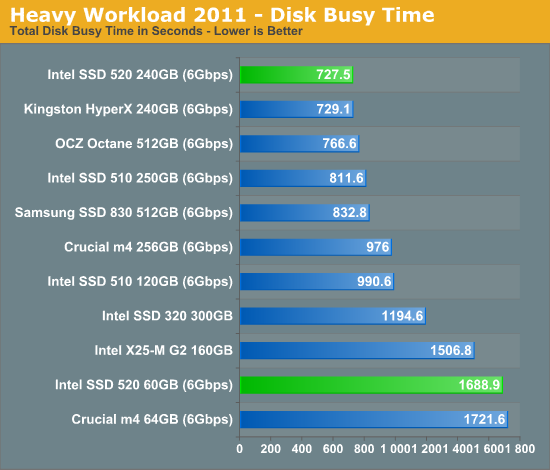
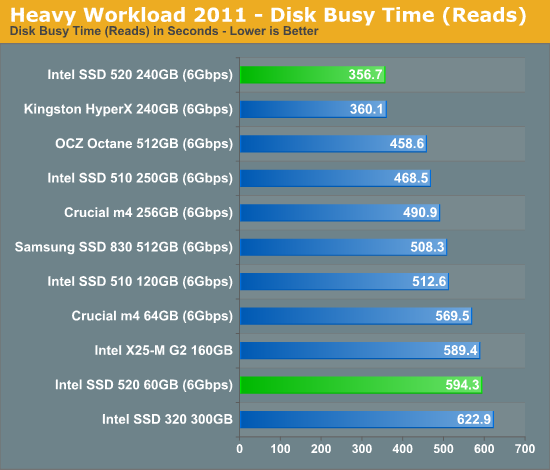
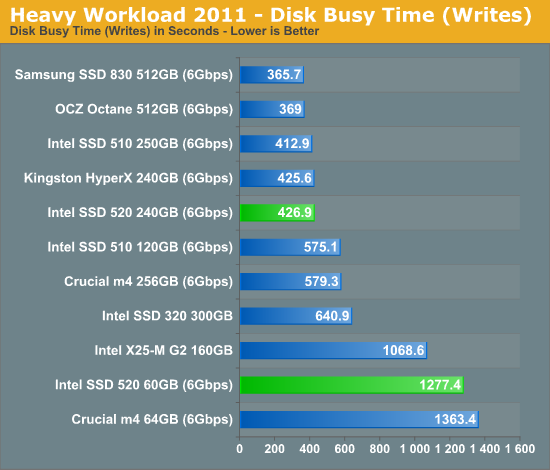










138 Comments
View All Comments
eman17j - Wednesday, February 8, 2012 - link
Are you trying to say that Amd's cpus are unreliable? I have one and I have no problems at all with it. I dont have crashes or freezes.bji - Wednesday, February 8, 2012 - link
He's a beginner. He doesn't know what he's talking about.eman17j - Wednesday, February 8, 2012 - link
Wrong because the business buys the drive at an higher price then raises the price on their product or service and passes the cost of the drive to the consumer so the consumer ends up paying for the price premium anywaysgamoniac - Monday, February 6, 2012 - link
Is playing game part of Brian's job description?Brian Klug - Monday, February 6, 2012 - link
Heheh, I guess you could say that for once, yes, playing BF3 was part of the job! :)-Brian
Oberst - Monday, February 6, 2012 - link
Seems like there is the first customer with the bsod bug in the intel forum. It seems like the reliability is no better than at all the other SF drives and it's just a matter of (bad) luck.http://communities.intel.com/message/149389#149389
Makaveli - Monday, February 6, 2012 - link
That tool installed his brand new Intel 520 drive in IDE mode?NitroWare - Wednesday, February 8, 2012 - link
You would be surprised how many laptop owners (and even desktop owners) are unaware that they should use AHCI mode. I can guarantee that there are millions of boards out there with modern HDD or SSD in non optimal mode.Another large tech site interviewed several mobo vendors about Z68 and most sad it was supposed to ship with RAID mode as default due to the SRT feature., the reality is much different.
2010 1st gen core i5 thinkpad has problems with third party SSDs which some users claim IDE mode is the only way they get their 'cheap' SSD working
There is a mentality that if a user knows how to physically install a drive then they do not need to do anything else. Then there is the old drivers issues, yeah whatever the motherboard came with at best.
That is something the chipset vendors need to work on. Some motherboards put up a warning if you try to turn AHCI off with an auto counter to re-enable it.
It is definitely possible that a BIOS can detect a SSD and at least put up a text message saying what the recommend setting is. It is hard to ignore such messages.
mustardman29 - Monday, February 6, 2012 - link
I was trying to tell the OCZ support guys ever since their latest firmware that the BSOD is still there. It happens a lot less but it's still there.They were trying to tell me it was something wrong with my system and that I should re-install windows. That the kind of thing I would expect to hear from a 1-800 number that goes to someone in India reading a script. Not from a drive manufacturer.
I'll never buy another OCZ drive. Not because of the problem but because of the way they are dealing with it. Pretending it's does not exist and telling people to re-install windows.
And yes, Sandforce deserves part of the blame for pretending there was no problem for a long time despite many people saying otherwise.
However, I would not hesitate to buy this intel drive. They obviously found the problem and fixed it with their own firmware. Something the controller manufacturer seems incapable of doing.
ckryan - Monday, February 6, 2012 - link
You're not crazy. SF2281s still have stability issues, and the TRIM related BSODs are still happening too. Most people won't ever have problems with a 2281, but many did and still live with the occasional problem. The last round of FW did indeed fix many problems (it solved mine), but others still suffer. I stopped using the drives just because I have quite a few I play with, but you can still get a 2281 to flop on TRIM every once in a while.I'm sure Intel really put the screws to Cherryville's FW, but I think some of the issues with 2281 and their ilk are still mysteries to the SF partners, and possibly even LSI/SF and Intel (the expect fewer problems?).
Here's hoping the next gen of the SF is bulletproof.